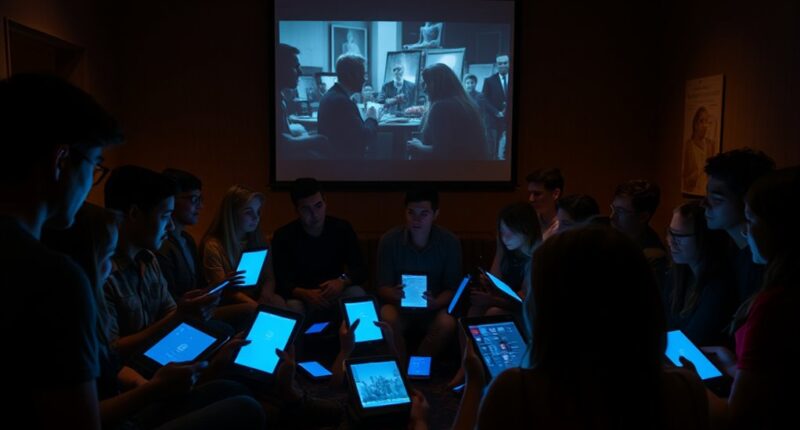In today’s digital age, film and media literacy is essential for you to think critically about the content you encounter. It helps you spot biases, assess source credibility, and differentiate facts from opinions. With overwhelming information and rapid misinformation spread, your critical thinking skills will guide you toward informed decision-making. Engaging with media responsibly empowers you to combat harmful influences while fostering community dialogue. There’s so much more to uncover about enhancing your media literacy journey.
Key Takeaways
- Critical thinking enhances the ability to identify biases and misinformation in film and media content.
- Understanding diverse media forms is essential for evaluating credibility and distinguishing fact from opinion.
- Digital age challenges, like misinformation and echo chambers, necessitate advanced media literacy skills.
- Education that integrates media literacy fosters informed decision-making and critical dialogue among youth.
- Community engagement and resources are vital for supporting effective media literacy initiatives and bridging knowledge gaps.
The Importance of Critical Thinking in Media Literacy
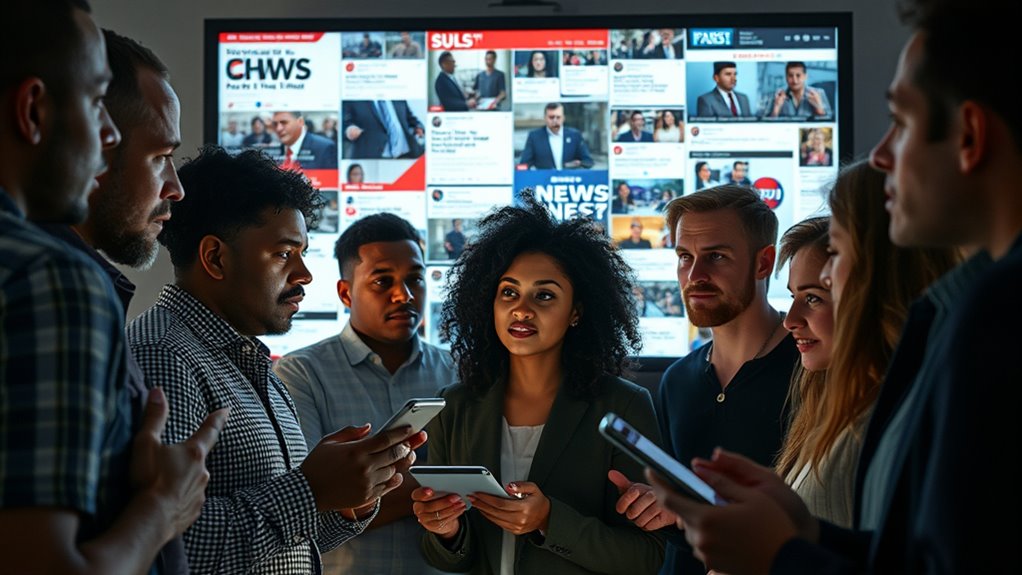
Critical thinking is the cornerstone of effective media literacy. It empowers you to identify biases and misinformation within various media content. By sharpening your critical thinking skills, you can evaluate source credibility and distinguish between fact and opinion. This skillset allows you to navigate complex media landscapes with confidence, fostering a nuanced understanding of messages and their underlying agendas. Furthermore, critical analysis promotes informed decision-making based on accurate information, reducing the spread of misinformation. As you engage with diverse media formats—from news articles to social media—you’ll recognize persuasive techniques and manipulation. Ultimately, enhancing your critical thinking skills is essential for becoming a more responsible media consumer and participating actively in today’s information-rich environment. Additionally, media literacy education equips individuals to recognize and resist negative media effects on attitudes and behaviors.
Skills for Navigating Media Messages

How can you effectively navigate the complex landscape of media messages? Start by understanding different media forms—television, radio, print, and digital. As you decode these messages, pay attention to the motives behind them.
Use critical thinking to evaluate the credibility of sources, ensuring you distinguish trustworthy information from misinformation. Recognize biases that may skew your perspective and challenge harmful portrayals. Additionally, media literacy fosters the ability to analyze and evaluate media messages, empowering you to make informed decisions.
When engaging with digital media, develop skills to protect your privacy and understand your digital footprint. Additionally, promote responsible media practices by advocating for accuracy and ethical content creation.
Challenges of the Digital Age

Steering through the digital age presents unique challenges that complicate media consumption. With an overwhelming amount of information online, distinguishing facts from misinformation can feel impossible.
Social media algorithms often trap you in echo chambers, limiting exposure to diverse viewpoints. Overconsumption can lead to information overload, making it hard to digest content effectively. Misinformation spreads rapidly, complicating your efforts to develop critical media literacy.
Meanwhile, advancements in AI introduce deepfakes, further blurring the lines of authenticity. Educationally, a lack of trained teachers and resources hinders effective media literacy instruction.
As technology evolves, keeping curricula relevant becomes a constant struggle, and economic disparities only widen the digital divide. These challenges require you to engage critically and stay informed.
Techniques for Media Analysis
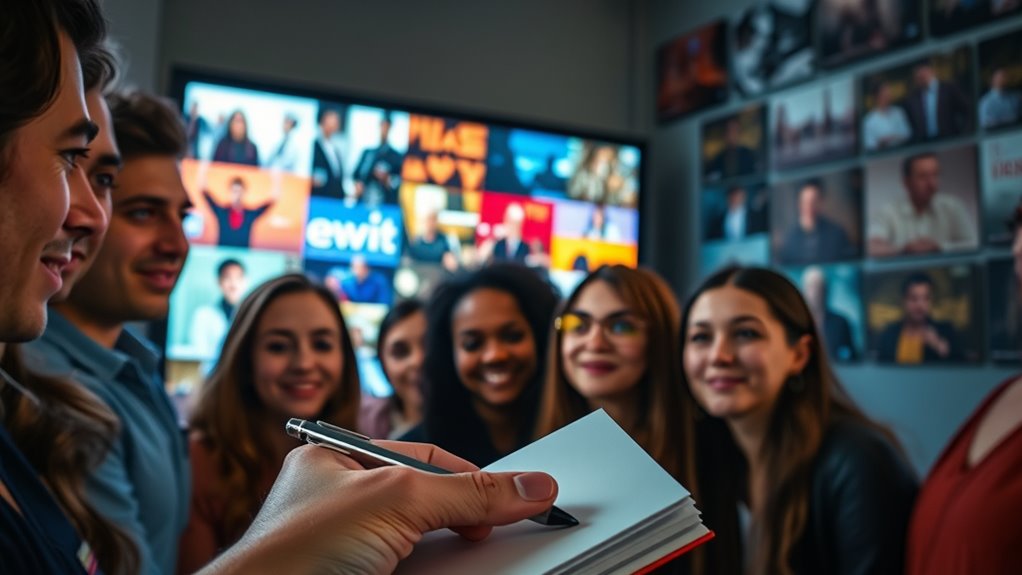
While traversing the complex landscape of media, employing effective techniques for analysis can greatly enhance your understanding.
Start by using semiotic theory to decode symbols and meanings in various media forms. Incorporate critical thinking exercises that challenge the messages you encounter, and utilize the SIFT method to verify sources and claims. Cross-check information against multiple outlets to spot biases. Additionally, consider how the semiotic theory helps in understanding the layers of meaning behind media texts.
Engage with questioning techniques to uncover the creator’s intentions and perspectives. Additionally, consider compiling annotated bibliographies to deepen your research.
The Role of Education in Media Literacy
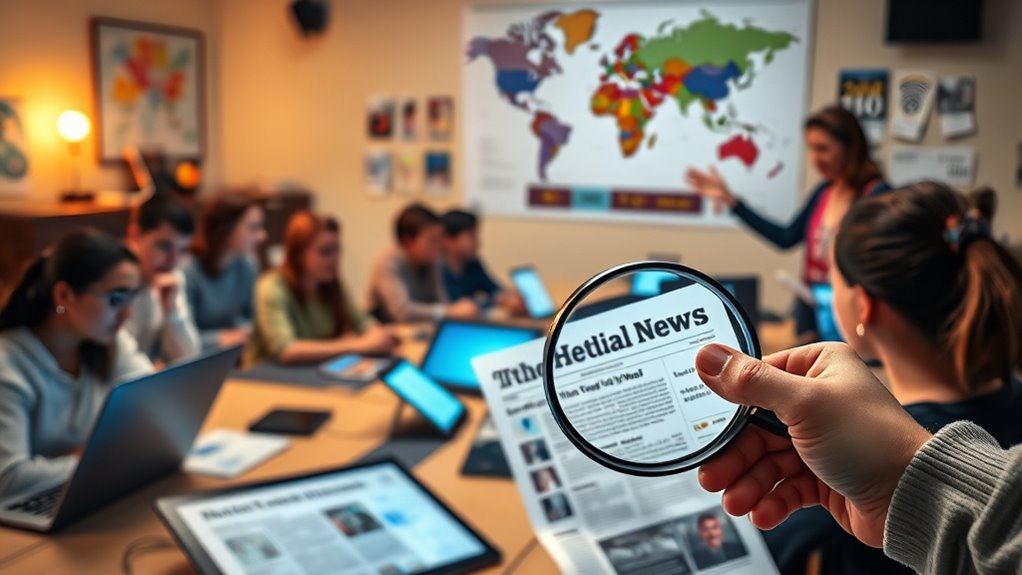
As education evolves, the role of media literacy has never been more essential in helping students navigate today’s complex media landscape.
Media literacy education fosters critical thinking, enabling you to analyze messages and make informed decisions. You’ll learn to distinguish credible sources from misinformation, a crucial skill in today’s information-saturated world. Many U.S. states now integrate media literacy into curricula, emphasizing its importance across academic subjects and daily life.
Engaging in project-based learning and critical discussions enhances your understanding of media influence. However, challenges like technological advancements and access disparities persist, requiring ongoing support and adaptation.
Enhancing Digital Citizenship Through Media Literacy

Understanding the interplay between media literacy and digital citizenship is essential for thriving in today’s online world. Media literacy equips you with the skills to access, analyze, evaluate, and create media, enhancing your critical thinking.
By examining media messages, you’ll grasp their societal influences and identify credible sources, which is vital for informed decision-making. Integrating these skills into digital citizenship means you engage responsibly online, considering safety and ethical behavior.
As you develop these competencies, you’ll foster an understanding of your digital footprint and how to participate in respectful online discourse. Ultimately, enhancing your media literacy strengthens your ability to navigate the digital landscape, ensuring you become a well-rounded and responsible digital citizen.
Engaging With Digital Media Responsibly
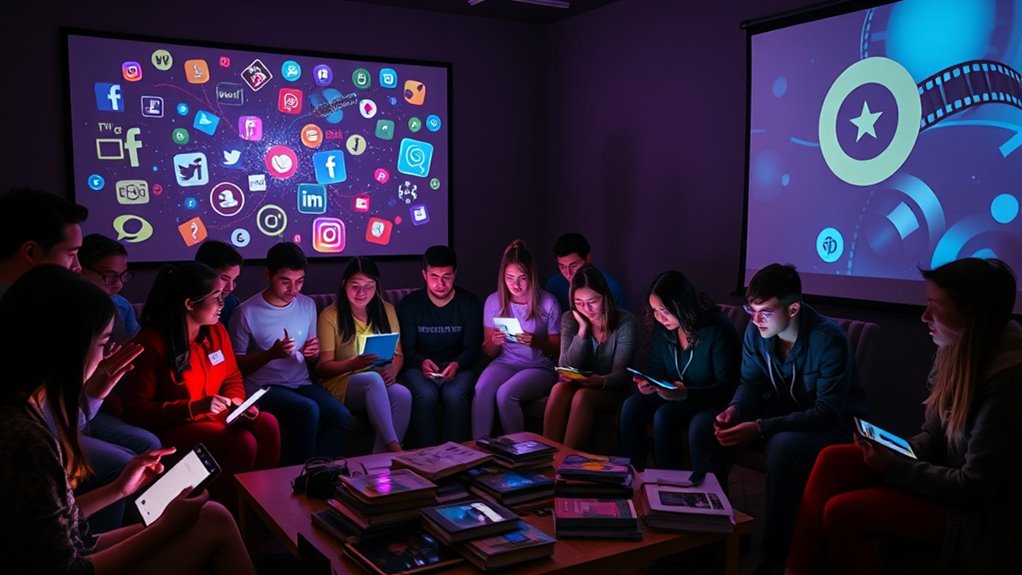
Maneuvering the digital landscape requires not just awareness but also responsibility in how you engage with media. Set ground rules for your digital use, ensuring open communication about online experiences.
Establish age-appropriate boundaries to promote safe social media interactions, especially for children. Balance your social media time with real-life relationships, and monitor your emotions to maintain mental well-being.
Educate yourself on online privacy settings and security to protect your information. When using social media, be mindful of what you share and consume.
Lead by example by practicing digital etiquette and engaging in respectful interactions. By fostering these habits, you’ll contribute to a healthier digital environment for yourself and others, empowering responsible engagement in the digital age.
Recognizing and Addressing Misinformation
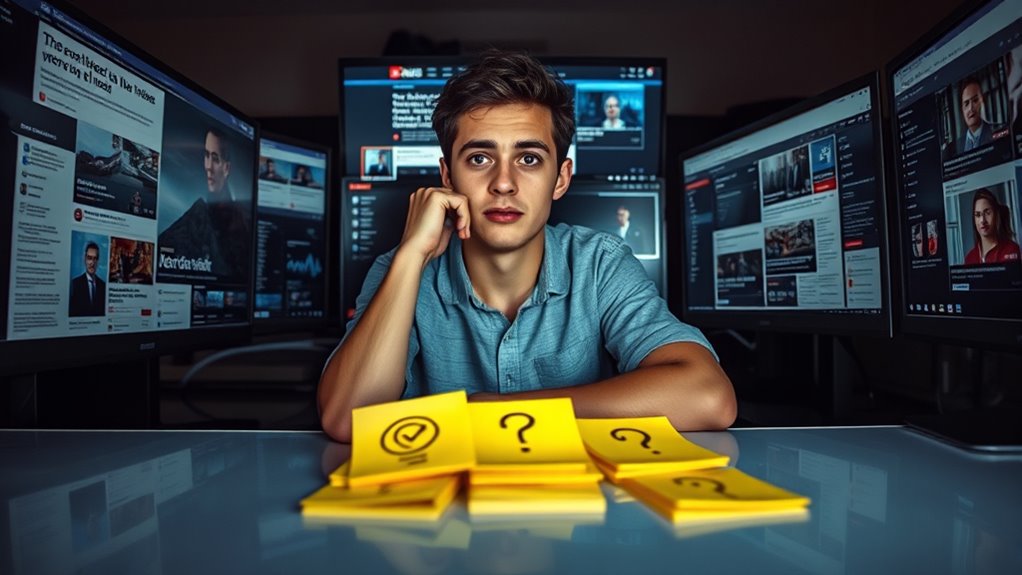
In a world where misinformation spreads rapidly, recognizing and addressing it has become crucial for everyone. Did you know that 38.2% of U.S. news consumers have unknowingly shared fake news?
With 4.9 billion social media users globally, the influence of misinformation is staggering. Critical thinking skills are essential to help you evaluate the evidence and plausibility of what you see online.
Schools are increasingly teaching media literacy to foster these skills, while AI tools can detect misinformation in real-time. However, you must also take responsibility by fact-checking before sharing.
Fostering Community and Social Engagement Through Media Literacy
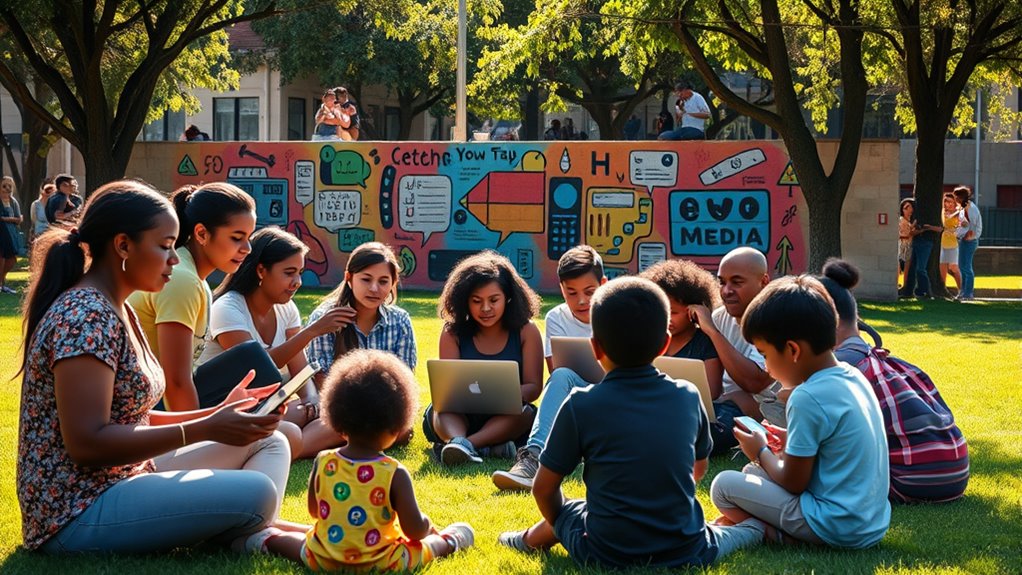
As local media becomes increasingly vital, fostering community and social engagement through media literacy has never been more essential. With 22% of youth regularly consuming local news, you can help create informed citizens ready to participate in civic activities.
Local news outlets, when partnered with community organizations, can amplify youth voices and enhance engagement through shared events and workshops. However, about 35% of youth feel their community lacks support in understanding political issues, highlighting the need for improvement. High-quality equipment is also crucial in ensuring that community-driven media projects effectively communicate their messages.
Frequently Asked Questions
How Can Parents Promote Media Literacy at Home?
To promote media literacy at home, you can encourage your kids to question the media they consume.
Ask them who created content and what message it sends. Foster open conversations about their online experiences, discussing feelings and actions inspired by media.
Set media boundaries by monitoring their screen time and ensuring diverse content.
Utilize resources and workshops to enhance your understanding, and model good media habits by using technology mindfully yourself.
What Are Some Examples of Effective Media Literacy Programs?
You can explore several effective media literacy programs.
PBS NewsHour Student Reporting Labs pairs high school students with media professionals for hands-on investigative reporting.
Admongo teaches younger kids to spot hidden ads through an engaging online game.
The Common Sense Media Curriculum focuses on digital citizenship issues like privacy and cyberbullying.
Additionally, the Media Detective Program uses a fun detective theme to help youth develop critical thinking and media analysis skills.
How Does Media Literacy Impact Children Differently Than Adults?
Did you know that children aged 8-18 spend over seven hours a day on screens? This excessive media consumption impacts their ability to critically evaluate information differently than adults.
While adults often draw from life experiences to assess content, children lack that framework, making them more susceptible to misinformation.
What Role Do Social Media Influencers Play in Media Literacy?
Social media influencers play a significant role in media literacy by shaping your perceptions and opinions. They use persuasive techniques, emotional appeals, and engaging content to connect with you.
As you consume their messages, it’s essential to evaluate their credibility and intent critically. Recognizing misinformation and understanding their impact helps you navigate the digital landscape.
How Can Individuals Assess Their Own Media Literacy Skills?
You can assess your media literacy skills by reflecting on your ability to evaluate information sources critically.
Start by analyzing the credibility of the content you consume—check the author’s background and look for biases.
Engage in hands-on activities like creating your own media, which helps you understand the production process.
Additionally, using self-assessment tools can guide you in identifying areas for improvement and enhancing your overall media literacy.
Conclusion
So, as you navigate the wild jungle of digital media, remember: critical thinking isn’t just a fancy skill—it’s your survival kit. Who needs to verify facts when you can just scroll mindlessly, right? But seriously, embrace media literacy like it’s the latest trend. Equip yourself to tackle misinformation and engage with content responsibly. After all, in a world where everyone’s a “news source,” you’ll want to be the smart one. Let’s face it, ignorance isn’t bliss; it’s a disaster waiting to happen!
